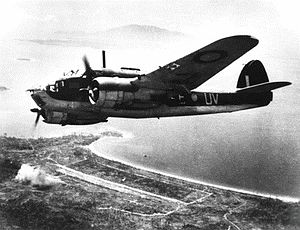- No. 8 Squadron RAAF
-
No. 8 Squadron RAAF 
A No. 8 Squadron Beaufort during an attack on Wewak in 1944Active 1917–1919
1940–1942
1943–1946Country Australia Branch  Royal Australian Air Force
Royal Australian Air ForceEngagements World War I
World War IINo. 8 Squadron was a Royal Australian Air Force flying training squadron of World War I and medium bomber squadron of World War II. The Squadron was first formed in October 1917 and was disbanded in January 1946 after seeing action during the Pacific War.
History
No. 8 Squadron was first formed as a flying training squadron of the Australian Flying Corps at Yatesbury, England on 25 October 1917. The squadron received its first aircraft in January 1918 and trained replacement pilots for No. 4 Squadron until being disbanded on 30 April 1919.
No. 8 Squadron was reformed as a bomber-reconnaissance unit at RAAF Base Fairbairn on 11 September 1940. Due to a shortage of other aircraft the Squadron was initially equipped with ex-civilian Douglas DC-2 and Douglas DC-3 transport aircraft which were used to conduct patrols off the Australian coast and for transport tasks. The Squadron was reequipped with Lockheed Hudson medium bombers in May 1940 and was deployed to Singapore in August. The Squadron first saw action within hours of the outbreak of war in the Pacific in December 1941 when it attacked Japanese shipping off Malaya. The Squadron suffered heavy losses in the first days of the Malayan Campaign and was virtually amalgamated with No. 1 Squadron RAAF later in December. No. 8 Squadron handed its remaining Hudsons to No. 1 Squadron in January 1942 and was evacuated to Palembang in Sumatra where it received replacement Hudsons. The Squadron continued to suffer heavy losses and was disbanded at Batavia on 16 February with its personnel returning to Australia.
No. 8 Squadron was reformed at RAAF Station Fairbairn on 12 March 1943 equipped with DAP Beaufort bombers as a medium and torpedo bomber squadron. The Squadron moved to Goodenough Island in August and began flying combat missions against Japanese positions and shipping in the New Britain area. The Squadron moved to the New Guinea mainland in April 1944 and flew strikes against Japanese positions near Wewak until the end of the war. No. 8 Squadron was disbanded at Tadji in New Guinea on 19 January 1946.
Aircraft operated
- Avro 504 (January 1918 – April 1919)
- Sopwith Pup (January 1918 – April 1919)
- Sopwith Camel (January 1918 – April 1919)
- Sopwith Snipe (?-April 1919)
- Douglas DC-2 (September 1939 – May 1940)
- Douglas DC-3 (September 1939 – May 1940)
- Lockheed Hudson (May 1940 – February 1942)
- DAP Beaufort (March 1943 – January 1946)
References
- RAAF Museum 8 Squadron
- Steve Eather (1995) Flying Squadrons of the Australian Defence Force. Aerospace Publications.
Main series 1 · 2 · 3 · 4 · 5 · 6 · 7 · 8 · 9 · 10 · 11 · 12 · 13 · 14 · 15 · 20 · 21 · 22 · 23 · 24 · 25 · 26 · 27 · 28 · 29 · 30 · 31 · 32 · 33 · 34 · 35 · 36 · 37 · 38 · 40 · 41 · 42 · 43 · 60 · 66 · 67 · 71 · 73 · 75 · 76 · 77 · 78 · 79 · 80 · 82 · 83 · 84 · 85 · 86 · 87 · 92 · 93 · 94 · 99 · 100 · 102 · 107 · 292 · Fighter · Rescue and Communication · Seaplane · Berlin Air Lift
Article XV squadrons Joint Netherlands-Australian squadrons Categories:- RAAF squadrons
- Military units and formations established in 1917
Wikimedia Foundation. 2010.
